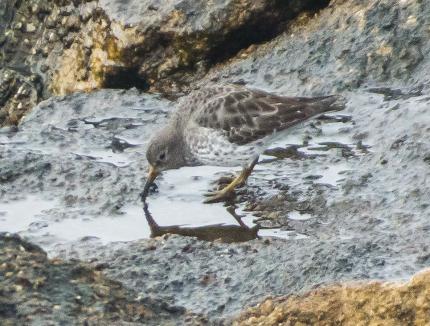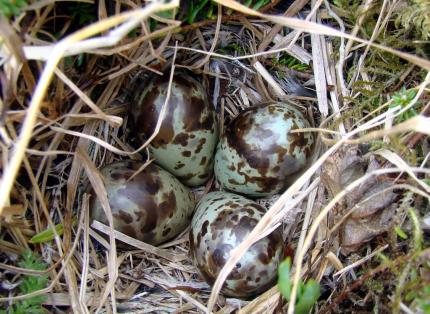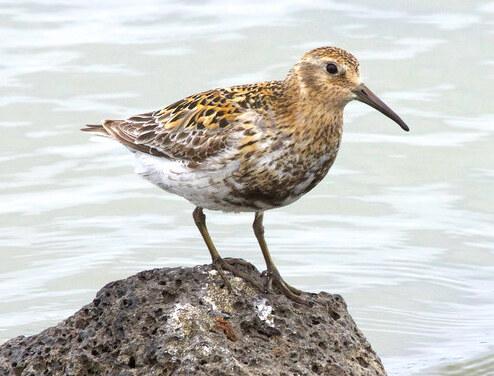Moderate
Washington has migratory and wintering populations of rock sandpipers. The population size of this shorebird species is low.
Studies predicting vulnerabilities of rock sandpipers to climate change indicate no change in risk associated with wintering and migration habitats; all breeding habitat exists outside Washington State, and does have expected increased risk associated with climate change.
Description and Range
Physical description

The rock sandpiper is about 9 inches in length. It has a slightly downcurved beak at the tip and has greenish-yellow legs. Breeding plumage includes a black patch on the breast. The head has a dark reddish-brown cap, and the back has black feathers rimmed with reddish-brown. Winter plumage is a charcoal overall but with a dark speckled white belly. Juvenile plumage is similar to breeding plumage but paler and no black patch.
The rock sandpiper is almost exclusively associated with rocky shoreline habitats. These areas include rock shorelines and rock jetties. They are sometimes found on sand beaches in very small numbers. Large numbers of rock sandpipers use mudflats in Alaska and also roost on floating ice there.
Washington has migratory and wintering populations of rock sandpipers. Rock sandpipers in Washington migrate to breeding sites on Pribilof and St. Matthew islands.
In Washington, rock sandpipers usually aggregate in small flocks (or as singles), although in Alaska they aggregate in flocks of hundreds or even thousands.
As might be indicated by the size and shape of their bill, rock sandpipers probe into rocky crevices and do not chip or pry prey from the surface of the rocks.
Ecology and life history
The rock sandpiper is almost exclusively associated with rocky shoreline habitats. These areas include rock shorelines and rock jetties. They are sometimes found on sand beaches in very small numbers. Large numbers of rock sandpipers use mudflats in Alaska and also roost on floating ice there.
Washington has migratory and wintering populations of rock sandpipers. Rock sandpipers in Washington migrate to breeding sites on Pribilof and St. Matthew islands.
In Washington, rock sandpipers usually aggregate in small flocks (or as singles), although in Alaska they aggregate in flocks of hundreds or even thousands.
As might be indicated by the size and shape of their bill, rock sandpipers probe into rocky crevices and do not chip or pry prey from the surface of the rocks.
Geographic range

Most rock sandpipers spend the winter in Alaska and British Columbia, and comparatively small numbers migrate as far south as California. The species is almost completely limited to outer coastal areas.
Perhaps fewer than 100 to 200 birds overwinter in Washington, although survey efforts along coastal areas are impractical in many areas, so this estimate is uncertain.
The abundance of rock sandpipers at Christmas Bird Count locations south of southern British Columbia declined beginning in the early 1980s, and this coincided with increases in abundance in Alaska, which suggested a range contraction.
For a map of worldwide distribution and other species' information, see NatureServe Explorer.
Climate vulnerability
Sensitivity to climate change
Moderate
Rock sandpipers are likely to have low physiological sensitivity to increases in air temperature. However, their overall sensitivity will be higher due to their dependence on habitats that may be negatively impacted by climate change. Rising sea levels and increased wave action may disturb prime foraging area and lead to declines in food sources (e.g., intertidal mussels). Additionally, during their Alaskan breeding season, declines in sea ice due to rising air and ocean temperatures could limit breeding and roosting habitat.
Exposure to climate change
Moderate
- Sea level rise
- Increases in wave action
Conservation
Conservation Threat and Actions Needed
- Resource information collection needs
- Threat: Lack of information about abundance in Washington.
- Action Needed: Work with partners on surveys to understand species distribution and abundance.
- Resource information collection needs
- Threat: Trends in populations are unknown.
- Action Needed: Conduct monitoring and demographic studies on the breeding grounds to understand population trend.
See the Climate vulnerability section for information about the threats posed by climate change to the rock sandpiper.
Resources
References
Andres, B. A., P. A. Smith, R. I. G. Morrison, C. L. Gratto-Trevor, S. C. Brown, and C. A. Friis. 2012. Population estimates of North American shorebirds, 2012. Wader Study Group Bull. 119: 178-194.
Galbraith, H., D. W. DesRochers, S. Brown, J. M. Reed. 2014. Predicting vulnerabilities of North American shorebirds to climate change. PLoS ONE 9(9):e108899. Doi:10.1371/journal.pone.0108899
Ruthrauff, D. R. 2014. On the frozen edge: environmental and physiological constraints in the life history of a northerly-wintering shorebird. PhD Thesis, University of Groningen, Groningen, The Netherlands.
